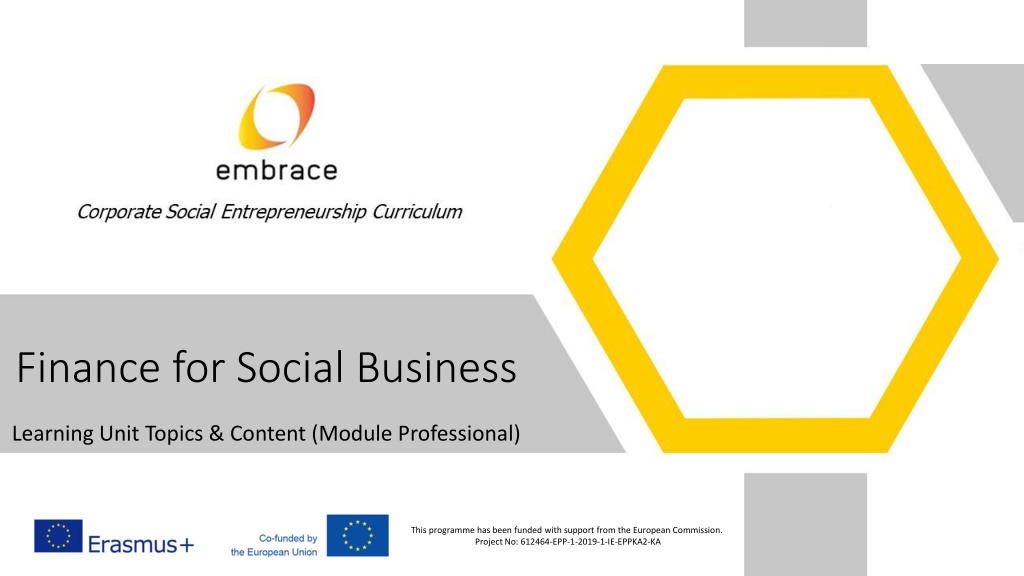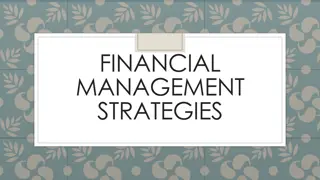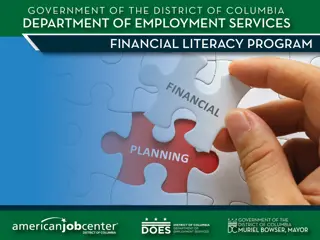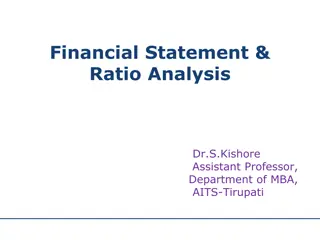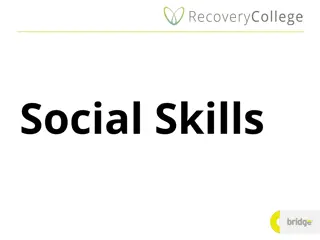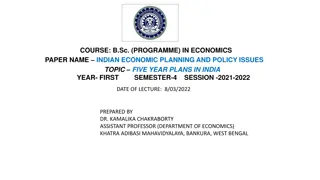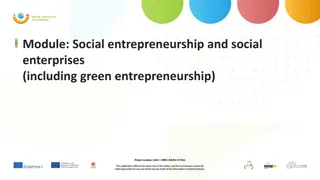Understanding the Importance of Financial Planning for Social Businesses
A financial plan is crucial for social businesses, providing a snapshot of current financial status and setting projections for growth. Components include profit and loss statements, cash flow statements, balance sheets, sales forecasts, personnel plans, and more. Financial planning helps set realistic goals, manage crises, attract investors, and prepare for long-term success.
Download Presentation

Please find below an Image/Link to download the presentation.
The content on the website is provided AS IS for your information and personal use only. It may not be sold, licensed, or shared on other websites without obtaining consent from the author. Download presentation by click this link. If you encounter any issues during the download, it is possible that the publisher has removed the file from their server.
E N D
Presentation Transcript
Finance for Social Business Learning Unit Topics & Content (Module Professional) This programme has been funded with support from the European Commission. Project No: 612464-EPP-1-2019-1-IE-EPPKA2-KA
Learning Unit Content Overview 1. Investment/Financial Strategy 1. Identifying financial needs and outlining a fundraising strategy 2. Value proposition & social impact investment 2. Choosing the Right Path 1. Recognizing options and opportunities 2. Advantages and challenges of external funding/support 3. Digital Fundraising 1. Donations 2. Crowdfunding 4. Offline Financing 1. Grants (public funds) 2. Private investment (impact investors, business angels) 3. Credit financing
Learning Unit Goals & Objectives Learning Goal Learners understand the opportunities of social entrepreneurship, social business, and non-profit-organizations. Instructional Objectives Learners will be taught the basics of financial strategy, marketing and fundraising. Learning Objectives Learners are able to name and explain basic steps for developing a financial/investment strategy including concrete options for on- and offline fundraising and marketing activities.
Topic 1: Financial Planning 1. Identifying needs and outlining a fundraising strategy 2. Value proposition & social impact investment
What is a financial plan? A financial plan is an overview of your current business financials and projections for growth. Think of any documents that represent your current monetary situation as a snapshot of the health of your business and the projections being your future expectations. Components of a financial plan 1.Profit and loss statement 2.Cash flow statement 3.Balance sheet 4.Sales forecast 5.Personnel plan 6.Business ratios and break-even analysis Make financial planning a recurring part of your business
Why is a financial plan important? A financial plan is a snapshot of the current state of your business. The projections, inform your short and long-term financial goals and gives you a starting point for developing a strategy. It helps you, as a business owner, set realistic expectations regarding the success of your business. You re less likely to be surprised by your current financial state and more prepared to manage a crisis or incredible growth, simply because you know your financials inside and out. And aside from helping you better manage your business, a thorough financial plan also makes you more attractive to investors. It makes you less of a risk and shows that you have a firm plan and track record in place to grow your business.
What is a financial strategy? A good financial strategy combines financial planning and strategic planning, promoting achievement of goals through careful, planned investment. https://www.batonglobal.com/post/how-to-write-mission-vision-and-values-statements-with- examples#:~:text=The%20mission%20statement%20communicates%20the,organization's%20core%20principles%20and%20ethics.
What is an investment? An investment is an asset or item acquired with the goal of generating income or appreciation. Appreciation refers to an increase in the value of an asset over time. When an individual purchases a good as an investment, the intent is not to consume the good but rather to use it in the future to create wealth. An investment always concerns the outlay of some capital today time, effort, money, or an asset in hopes of a greater payoff in the future than what was originally put in. An investment involves putting capital to use today in order to increase its value over time. An investment requires putting capital to work, in the form of time, money, effort, etc., in hopes of a greater payoff in the future than what was originally put in. An investment can refer to any medium or mechanism used for generating future income, including bonds, stocks, real estate property, or a business, among other examples. https://www.investopedia.com/terms/i/investment.asp
Available for Investment Understanding that investment can take many shapes enables businesses to take advantage of a variety of resources. Considering all available investment resources when developing a financial plan promotes optimal use of financial resources. What resources can be invested? Time Physical assets Money
How to spend your startups initial investment One of the keys to spending wisely is in treating the money you have no matter where it came from like it s your money. Bootstrappers often talk about the way spending your own hard-earned cash makes you rethink the quality of every investment. This is a healthy mindset toward investment. Let me propose the following breakdown of how to spend the money you ve got, be it $1 million or $10,000. Up to 20% on market research At least 75% on building your minimum viable product Whatever s left over on the rest of the stuff that seems important at the time
1.2 Value proposition & Social Impact Investment What is a value proposition? A company's value proposition tells a customer the number one reason why a product or service is best suited for that particular customer. A value proposition should be communicated to customers directly, either via the company's website or other marketing or advertising materials. Value propositions can follow different formats, as long as they are "on brand," unique, and specific to the company in question. A successful value proposition should be persuasive and help turn a prospect into a paying customer. Understand Value: https://www.bain.com/insights/elem ents-of-value-interactive/ https://www.investopedia.com/terms/v/valueproposition.asp
Value Proposition What is the purpose of a value proposition? A value proposition is meant to convince stakeholders, investors, or customers that a company or its products/services are worthwhile. If the value proposition is weak or unconvincing it may be difficult to attract investment and consumer demand. What is an employee value proposition? An employee value proposition (EVP) applies to the job market. Here, a company that is hiring will try to frame itself as a good place to work, offering not only monetary compensation but also a range of benefits, perks, and a productive environment. In return, the job candidate will need to convince the hiring company that they have the appropriate skills, experience, demeanor, and ambition to succeed. What happens if a value proposition fails? If a company cannot convince others that it has value or that its products or services or valuable, it will lose profitability and access to capital and may ultimately go out of business.
Value Proposition Canvas The Value Proposition Canvas is a business model tool that helps companies to identify if their product or service is targeting the customer and is positioned around their needs and values.
Impact Investment Impact investing is a general investment strategy that seeks to generate financial returns while also creating a positive social or environmental impact. Investors who follow impact investing consider a company's commitment to corporate social responsibility or the duty to positively serve society as a whole. Socially responsible (SRI) and environmental, social, and governance (ESG) investing are two approaches to impact investing, although there is still some disagreement over terminology in the investing community. https://www.investopedia.com/terms/i/impact-investing.asp
Social Impact Investment Socially responsible investing is the practice of investing money in companies and funds that have positive social impacts. Socially responsible investing has been growing in popularity in recent history. Investors should keep in mind that socially responsible investments are still investments and be sure to weigh the potential for return into their decisions. Community investing is a type of investing where the return is measured on community impact rather than monetary return. Socially responsible investments tend to mimic the political and social climate of the time.
1.3 Marketing Strategy The marketing plan details the strategy that a company will use to market its products to customers. The plan identifies the target market, the value proposition of the brand or the product, the campaigns to be initiated, and the metrics to be used to assess the effectiveness of marketing initiatives. The marketing plan should be adjusted on an ongoing basis based on the findings from the metrics that show which efforts are having an impact and which are not. Digital marketing shows results in near real-time, whereas TV ads require rotation to realize any level of market penetration. A marketing plan is part of a business plan, which describes all of the important aspects of a business, such as its goals, values, mission statement, budget, and strategies.
Would crowdfunding be a good marketing option? You are at home in the world of social media and have existing social networks via Facebook, Twitter, LinkedIn or other websites. You want to raise $1 million or less this way. You have an idea that you can clearly communicate to your friends, family, and other potential supporters. Your idea solves a problem and therefore has a target market that you can define in your pitch. You are prepared to be transparent with potential investors about who you are, why you are excited about this idea, and why you know you can succeed.
Investment Pitch - Checklist Tell potential investors about your idea or concept at networking events or other conversations. Before you tell a potential investor about your idea, you should have been in contact with them or have met them before (business network). Business events, start-up fairs, meetings, LinkedIn are good ways to make first contacts. Make sure your business is in its best state. (website, social media, mission, vision and value statement) Know your numbers, processes and details Have your own story that makes your business/idea unique Share your personal background and experiences Be as transparent and honest with your potential investors (don't lure them with false promises) An elevator pitch is a slang term that refers to a brief speech that outlines the idea for a product, from venture capitalists and angel investors. service, or project. An elevator pitch gets its name from the notion that the speech should be short no longer than the time period of an elevator ride or about 30 to 60 seconds long. The objective of an elevator pitch is to pique the listener's curiosity enough for them to take any action, such as asking for more information or scheduling a follow-up meeting. Project managers, salespeople, and job seekers use elevator pitches as a way of marketing themselves, their products, or their ideas. Entrepreneurs use elevator pitches to help obtain Start-up capital
Online vs Offline marketing Pro Online Marketing Con Online Marketing Easy to measure Depending on technology Long-Term exposure Worldwide competition Easy to target key audience Customers often ignore online ads Affordable Limited face to face contact Greater reach Pro Offline Marketing Con Offline Marketing Provides customers with something tangible Difficult to measure Built relationship while networking Only runs for a short period of time Reach audience when they are attentive High costs Greater creativness Limited Accessibility
Social Media Marketing and the different channels Social Media gives a Start-up a cheap, fast and easy opportunity to connect with people and customers. It is important to take time to identify the target audience and tailor a social media campaign appropriately Do s and don ts https://www.forbes.com/sites/forbescommuni cationscouncil/2020/07/20/the-dos-and- donts-of-social-media-marketing-in-2020/ https://www.wordstream.com/social-media-marketing
2 types of Social Media Communication Proactive communication All activities are initiated from the company The communication starts with the company The goal is to deliver an opportunities from groups to feel engaged and addressed. Due to interest customers will react. Reactive communication The customer is searching for the interaction React to interviews, posts and comments Collecting similar questions from customers and answer them collectivly.
Assessment Name two pros and cons for each online and offline marketing What are the three sources that can be invested? What components go into a financial plan?
Topic 2: Choosing the Right Financial Path Knowing the options for financing a business or generating donations for a non-profit along with their associated advantages and disadvantages will inform the decision- making process on who and how to engage with external organisations or individuals for financial support. 1. Recognizing options and opportunities 1. Overview of financial options Ask the right questions Advantages and challenges of external financial support 1. Whether the goal is to start-up a non-profit or a business, it is important to know the what to expect from external financial support. 2. 3.
Overview of Options & Opportunities Options for financing a new venture fall into three main categories: WATCH Founder Series 2020: Finding the Right Financing For Your Startup - YouTube 1. Self-funding Most startups begin with their own savings. READ: Self-Financing Your Startup (entrepreneur.com) Friends & Family Our closest contacts are often the first to buy into our business ideas. READ: Getting Seed Funding from Friends and Family the right way (jonathanhung.com) Fools Sooner or later, most businesses look externally for funding options. Banks Investors Fundraising Grants 2. 3.
Ask the right questions Seven important questions to ask when creating a funding strategy: READ How to Choose the Best Funding Path for your Startup - LighterCapital
What funding path best suits your business growth strategy? The growth trajectory you envision for your business should have a major influence on your funding strategy. You should know what you want the business to look like in one, five, and 10 years before you make decisions on what type of funding makes sense. Source: How to Choose the Best Funding Path for your Startup, Lighter Capital, 2015
How much capital do you need? A well-thought-our business plan and capital-raising strategy can help you figure out how much capital you need. Your business plan should tell you what your growth milestones are in 6 months, 1 year, and 3 years. Then figure out what you need to do and how much it will cost you to go from one milestone to the next. Be aware of the pitfalls of raising too much money The more you raise, the more you need to pay back Easy money can take you off-track You might not be ready for rapid growth Source: How to Choose the Best Funding Path for your Startup, Lighter Capital, 2015
How much equity are you willing to give up? If you are looking to remake a market and need millions of dollars to scale, the venture capital path is likely to be the only route to get you the firepower you need. In this scenario, you will likely need to give up 10 to 45% of equity in exchange for the big infusion of capital you require. If you are looking to build a more modest company without a $1 billion exit but with recurring revenues and clear paths to profitability, it might be smarter to first explore debt options that don t dilute equity. Even if you plan to eventually raise venture capital, growing your company beforehand can also improve your company s valuation, which means you will need to give up less equity for the amount of funding you raise. Source: How to Choose the Best Funding Path for your Startup, Lighter Capital, 2015
What are you willing to risk to fund your business? Personal financial risk Traditional loans might require proof of phyisical assets as collateral before approving a loan. This could put savings or personal property at risk. Loss of control When giving up equity in your company, contol over decision-making can be diluted Traditional bank loans have fewer strings attached, but may impose limitations on how a loan may be spent Risks to personal relationships Personal connections that invest in your business may not be prepared to stay invested over the long-term. An exit plan for such instances can help prevent strain on important relationships Source: How to Choose the Best Funding Path for your Startup, Lighter Capital, 2015
How do you want to repay the money? Most financing requires not only repayment, but also interest. Fixed payments Must be paid on-schedule, regardless of how profitable your business is Revenue-based financing Repayment based on the ebb and flow of a businesses revenue Expectations The fine print Source: How to Choose the Best Funding Path for your Startup, Lighter Capital, 2015
Do you want guidance in growing your business? Who makes decisions Who influences decisions Who has control Source: How to Choose the Best Funding Path for your Startup, Lighter Capital, 2015
How long can you spend raising funds? Time spent chasing money is time not spent running your business. Before you seek financing, consider how long it will take to raise funds and how much of a distraction it will be. How much time will you spend courting potential investors? How much time will you spend gathering financials and filling out paperwork for a traditional bank loan? Can your business thrive while the CEO is out raising funds for an extended period of time? Source: How to Choose the Best Funding Path for your Startup, Lighter Capital, 2015
Advantages of External Financial Support Preserving Your Resources One of the advantages of external funding is it allows you to use internal financial resources for other purposes. If you can find an investment that has a higher interest rate than the bank loan your company just secured, it makes sense to preserve your own resources and put your money into that investment, using the external financing for business operations. You can also set aside your internal financial resources for cash payments to vendors, which can help improve your company's credit rating. Growth Part of the reason organizations use external funding is it allows them to finance growth projects the company could not fund on its own. For example, if your business is growing to the point that you need additional manufacturing space to keep pace with demand, external financing can help you get the funding you need to build your addition. External funding can also be used for making large capital equipment purchases to facilitate growth that the company cannot afford on its own. Advice and Expertise Organizations willing to finance your business can often also be useful sources of expert advice. Your banker, for example, has funded many other small businesses and may be able to offer guidance as to how to avoid pitfalls that created problems for some. An investor in your technology start-up likely has technology expertise of his own to offer, and even if not, may be able to steer you towards useful sources of advice.
Challenges of External Financial Support Ownership Some sources of external financing, such as investors and shareholders, require you to give up a portion of the ownership in your company in exchange for the funding. You may get that large influx of cash you need to launch your new product, but part of the financing agreement is the investor is allowed to vote on company decisions. This can compromise the vision you originally had for your company when you founded it. Interest External funding sources require a return on their investment. Banks will add interest to a business loan, and investors will ask for a rate of return in the investment agreement. Interest adds to the overall cost of the investment and can make your external funding more of a financial burden than you had originally planned. It's a Lot of Work Securing external funding can be a nearly full-time job in its own right. You're faced with the task of identifying potential sources of funding, preparing a slick business plan, practicing a presentation, and calling dozens of people to arrange or try to arrange a face-to-face meeting. All of these tasks take a good deal of time and resources. None of them are a guarantee that you'll get the funds you're seeking.
Assessment Name three typical sources of financing for a new business? Name four important questions to ask when considering what type of financing to pursue. Name two advantages and two challenges associated with aquiring external financial support.
Individual & Group Evaluation Individual Develop a financial strategy for a food startup with a goal of distributing within a 100 km radius within one year, based on your current financial situation. Group
Next Steps Once a decision has been reached, it is time to get started. The following sections of this learning unit will prepare you to: Take advantage of online tools and current trends for engaging with potential financial partners and supporters for successful digital fundraising Proceed with offline options for financing a business or non-profit venture
Topic 3: Digital Fundraising What is digital fundraising? Digital fundraising is about using all the digital channels at your disposal in an integrated way to reach and expand your audiences, spark engagement, and grow your giving opportunities. Developing a digital fundraising strategy is particularly helpful to reach beyond your local community and engage a broader audience interested in supporting your cause. WATCH: 10 Strategies for Success with Digital Fundraising
Methodology The Digital Fundraising Methodology contains three main steps: 1) Attract 2) Nurture 3) Convert Source: CauseVox
Benefits of Digital Fundraising Benefits of Digital Fundraising Methodology Improve Retention Reduce Workload Increase Acquisition Enhance Adaptability READ (Chapter 3: Benefits of using technology for fundraising) ECNL Comparative research on digital fundraising 2021 FINAL.pdf
Examples of Digital Fundraising Homepage/website Salvation Army Crowdfunding best platforms of 2022 Online fundraising use a service like JustGiving Social media facebook, instagram, etc. Text donations Whole Whale (top in 2022) Online gaming what it s all about Email 9 tips for success List Source: What is digital fundraising? | Synopsis (cultural-storytelling.eu)
Did you know In 2021, the social sector mastered the art of resilience. We saw countless organizations craft donation experiences that not only sustained a year-plus pandemic but set new standards for fundraising excellence. -Elizabeth McDonough, Classy
5 Fundraising Trends in 2022 1. Flexible giving options 2. Personalized donor experiences 3. Tech-driven events 4. Evolved recurring giving 5. Community through workplace giving Reading: https://learning.candid.org/resour ces/blog/five-fundraising-trends- to-capitalize-on-in-2022/
Trend 1: Flexible Giving Options Flexible donation options include: Convenient digital wallets, like Google Pay and ApplePay Cryptocurrency donations Trusted payment apps, like PayPal and Venmo Data from Classy s annual Why America Gives report shows that donors are completing more donations on their mobile devices than ever before. There s also growing enthusiasm around giving through QR codes, smartwatches, and wearables.
Trend 2: Personalized Donor xperiences Personalization is critical to building relationships that result in loyal donor bases. Nonprofit interactions with supporters need to be tailored according to their stage of life, intent, and preferences for communication. Customized donation forms Segment donors Matching gift tools Appeal to donor s interests Special events and campaigns
Trend 3: Tech-driven Events Hybrid events benefit both in-person and virtual attendees with advanced, tech-driven experiences that take lessons from the many virtual events staged during the pandemic. For national non-profits, hybrid is a way to stay frictionless. For local organizations, hybrid events can open new opportunities to enhance donor relations. Technology-driven experiences will continue to bring causes beyond their physical city borders.
Trend 4: Evolved Recurring Giving Recurring giving accounts for 26% of online revenue for organizations that raise over $50 million in total donation volume on Classy, as noted in The State of Modern Philanthropy. The technology is simple, and the impact of just a handful of recurring donations made, tracked, and nurtured online can mean sustainable income for years ahead without requiring additional resources. READ Donor Retention and Recurring Giving (donorsnap.com)
Trend 5: Community through Workplace Giving Employee engagement programs and the heightened desire to make an impact are leading people to look for more purpose in their day to day. Nonprofits and new startups can meet the moment by bringing their missions to workplaces knowing that donors are likely to find out about new causes through word of mouth within their close circles. WATCH What is workplace and employee giving? https://youtu.be/ICaZXq74Y9Y
